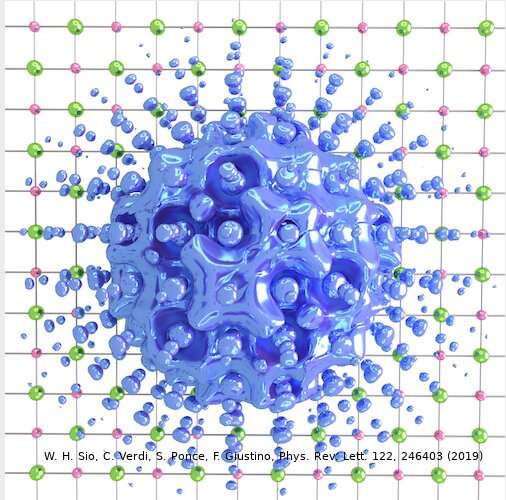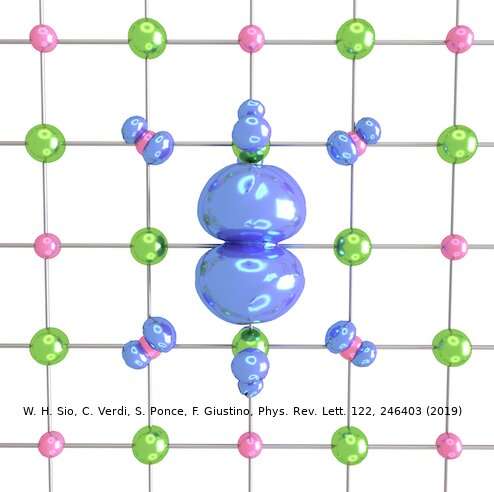July 8, 2019 feature
A new method to study polarons in insulators and semiconductors

A team of researchers at the University of Oxford have recently introduced a new way to model polarons, a quasiparticle typically used by physicists to understand interactions between electrons and atoms in solid materials. Their method, presented in a paper published in Physical Review Letters, combines theoretical modeling with computational simulations, enabling in-depth observations of these quasiparticles in a wide range of materials.
Essentially, a polaron is a composite particle comprised of an electron surrounded by a cloud of phonons (i.e. lattice vibrations). This quasiparticle is heavier than the electron itself and due to its substantial weight it can sometimes become trapped in a crystal lattice.
Polarons contribute to the electric current that powers several technological tools, including organic light-emitting diodes and touchscreens. Understanding their properties is thus of key importance, as it could help to develop the next generation of various devices for lighting and optoelectronics.
"Previous work on polarons relied on idealized mathematical models," Prof. Feliciano Giustino, the head of the team who carried out the study, told Phys.org. "These models have been very useful to understand the basic properties of polarons, but they do not take into account the structure of materials at the atomic scale, therefore they are not sufficient when we try to study real materials for practical applications. Our idea was to develop a computational methodology that would enable systematic investigations of polarons with predictive accuracy."
The method devised by Giustino's team is based on the density-functional theory, which is currently the most popular tool for predictive materials modeling and design using quantum mechanics. One of the primary challenges encountered when studying polarons based on this theory is that the required computational resources (CPU hours) are proportional to the third power of the number of atoms to be simulated. In other words, if one was studying two crystals with 10 and 20 atoms per unit cell, the calculation required to study the second crystal would be 8 times more time-consuming than that required for the first.

As many polarons are 1-2 nanometers in size, calculations for studying these systems would require simulation cells with at least 3,000-5,000 atoms. Yet current computation capabilities would struggle to sustain such simulations and each one of the many calculations necessary to investigate these systems would take weeks, even when using a modern supercomputer.
"Our idea was to try and make this process more efficient by leveraging advances in so-called density-functional perturbation theory," Weng Hong Sio, the first author of the work, explained. "Without going into the details, we were able to recast the problem of performing one calculation of a polaron in a large simulation cells into the simpler problem of performing multiple calculations in the smallest unit cell of the crystal. This strategy opened up new possibilities that were previously inaccessible."
The approach devised by Giustino's team can be used to describe both large and small polarons. In their study, for instance, the researchers showed how it can be used to calculate the wave functions, formation energies and spectral decomposition of polarons in LiF and Li2O2 compounds. Using their simulation method, they discovered that polarons in simple salts and metal oxides used in batteries have a far richer internal structure than suggested by previous works in the field.
"For example, in the prototypical salt lithium fluoride, it was previously thought that the polaron arises from the interaction between an electron and longitidinal optical phonons, i.e. the lattice vibrations that are responsible for the dielectric response of the crystal," Sio explained. "We found that these are not the only phonons involved, and that the interaction between the electron and piezoacoustic phonons (i.e. the vibrations responsible for piezoelectricity) is also important."
The observations gathered by Giustino's team change the current perspective on the polarons in salt lithium fouride, which is a very simple system. Applying their method to more complex systems could unveil even richer structures, ultimately enhancing our current understanding of their properties and informing the development of new materials with tailored polatronic properties. In their future research, the researchers plan to use their method to study other materials, in order to further assess its predictive power and attain a better understanding of other technologically important materials.
"Further down the line it will be important to investigate what a polaron can do: for now we know that we can calculate the lowest energy configuration of a polaron, but we have no clue on what happens if this polaron is subjected to static electric or magnetic fields or to electromagnetic radiation," Giustino said. "In addition, close interactions with experimental groups will be essential to translate these findings into applications."
More information: Weng Hong Sio et al. Polarons from First Principles, without Supercells, Physical Review Letters (2019). DOI: 10.1103/PhysRevLett.122.246403
Viewpoint: Polarons get the full treatment: physics.aps.org/articles/v12/68
Materials modelling using density functional theory. global.oup.com/academic/produc … 62432?cc=gb&lang=en&
Journal information: Physical Review Letters
© 2019 Science X Network



















